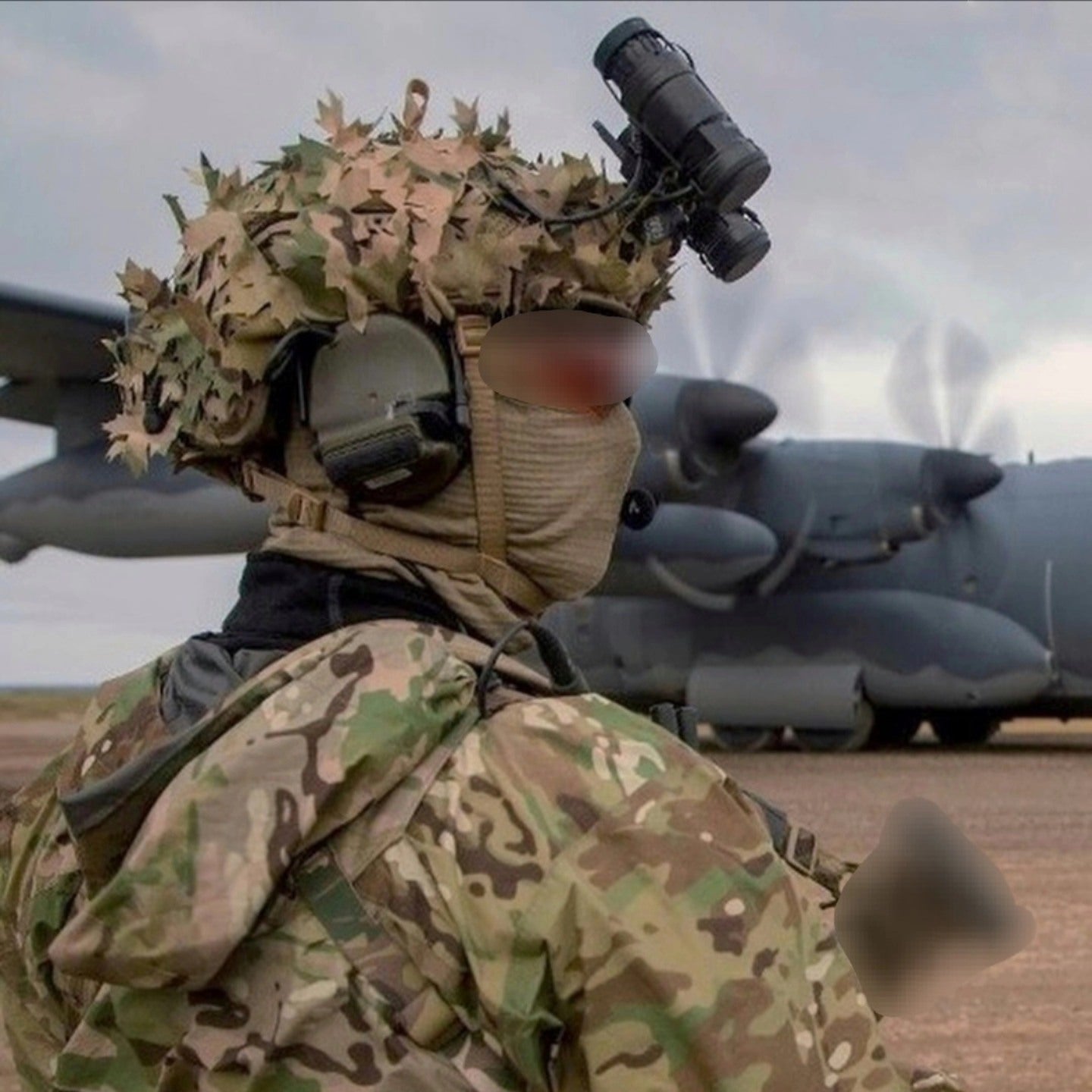The Future of Military Camouflage: Toward Total Invisibility?
Camouflage has always followed warfare. Over time, it evolved. Bright uniforms gave way to neutral tones. Patterns became complex, paints turned stealthy, and now, technology takes the lead.
The military camouflage of the future is no longer just a color or a pattern. It’s a responsive skin — an intelligent interface between soldier and environment. It relies on metamaterials, photonics, and nanoscale engineering to manipulate light and heat. It doesn’t imitate nature; it extends it. The goal is no longer to hide but to erase presence itself.
Yet behind that scientific feat lies a question: what does war become when the enemy can no longer be seen?
Active and Adaptive Camouflage: Surfaces That Think and React
Active camouflage no longer conceals passively. It observes. It understands. It replicates. It turns an object into a system that interacts with its surroundings. A constant conversation begins between matter and light.
Adaptive Polymers and Nanotechnologies
Everything starts with material science. Electrochromic polymers, liquid crystals, and nanostructured films shift color when exposed to electrical or thermal signals. Built-in sensors read ambient light, shadows, and reflections. The system reacts like living skin: it perceives, processes, and adapts.
Military laboratories are already testing this technology. The Chameleon Project, developed by France’s DGA and Nexter, experiments with pixelated panels that mimic terrain color and texture.
In North America, electrochromic uniforms adjust automatically to light intensity. Biology inspires defense: like cephalopods, these surfaces evolve and blend.
Military Applications
On the battlefield, the implications are vast. An armored vehicle could blend into sand, forest, or asphalt. A soldier, wearing an active fabric, could fade into the background in seconds.
The Adaptiv system, developed by BAE Systems, illustrates this potential. Hexagonal thermal tiles imitate the infrared signature of civilian vehicles or natural landscapes.
This new camouflage operates across three domains — visual, thermal, and cognitive. It deceives both the human eye and electronic sensors. Visibility becomes a variable rather than a constant.
Current Limitations
These advances come at a price. They require power, regular maintenance, and durable materials. They remain costly and sometimes directionally limited: invisible from one angle, detectable from another.
Still, rapid progress in flexible electronics and nanomaterials points toward lighter, more autonomous systems. Within a decade, adaptive camouflage could equip reconnaissance units or special forces.
Metamaterials and Advanced Optics: Bending Light to Vanish
Tomorrow’s camouflage doesn’t rely on color. It works directly with light. Metamaterials change how electromagnetic waves behave around matter. Their goal: to redirect light — and perception — away.
The Principle Behind Metamaterials
A metamaterial is an artificial structure, engineered at the nanoscale. By precisely shaping its internal geometry, scientists control how it interacts with light. In 2006, researchers at Duke University made a small cylinder invisible to microwaves — the first physical demonstration of engineered invisibility.
Since then, research has shifted toward visible light. “Transformation lenses” can guide light around an object, leaving the observer to see only the background.
The object itself seems to vanish. The light doesn’t penetrate; it flows around it.
Physical and Industrial Limits
Such materials are difficult to produce. Each works only within specific frequencies: a design optimized for radar will not function in visible light. Manufacturing requires nanometric precision. The slightest flaw breaks the illusion by scattering light.
Perfect invisibility remains theoretical, but partial, directional invisibility is already feasible. It’s enough to reduce radar cross-sections or infrared detection ranges.
Toward Operational Optical Camouflage
Some companies, like Hyperstealth Biotechnology, claim to have achieved it. Their Quantum Stealth film deflects both visible and infrared light, erasing human shapes at distance. Technical details remain classified, but the concept is proven: control the path of light, and you control what’s seen. Stealth becomes optical rather than visual.
Thermal and Infrared Invisibility: Erasing Heat to Deceive Sensors
On modern battlefields, the most dangerous eyes see in heat, not color. Escaping thermal sensors requires mastering temperature as if it were light.
Thermoregulated Coatings
Thermoregulated coatings alter their surface temperature to match the surroundings. They fine-tune energy emission, blending seamlessly into the thermal landscape. The Adaptiv system’s tiles reproduce the ambient heat pattern, making tanks appear as part of the terrain.
New materials, such as graphene, enhance this principle. Graphene’s conductivity enables electrical control over thermal radiation. A uniform or vehicle coated with it can appear cold, even when running hot.
This shifts the logic of stealth: the goal is not to eliminate heat, but to shape its signature.
Thermal Decoys and Emission Suppression
Deception complements concealment. Thermal decoys project false heat signatures to mislead sensors. Missiles lock onto fake targets. Inflatable, heated dummies simulate tanks or aircraft.
Meanwhile, heat suppression systems attack the source — cooling exhaust gases, isolating hot components, and redistributing energy. Borrowed from aerospace stealth, these methods now protect ground and naval units.
Heat becomes as strategic as firepower. Control it, and you dominate the dark.
Multi-Spectral and Quantum Camouflage: The Pursuit of Total Disappearance
The next frontier is multi-spectral camouflage — invisibility across all domains: visible, infrared, radar, even sound.
Quantum Camouflage
Quantum physics offers the most radical path. By manipulating photons directly, researchers explore ways to warp light at its fundamental level. “Temporal cloaks” have already hidden events occurring over fractions of a second. Invisibility becomes not just spatial but temporal.
Still experimental, these breakthroughs hint at a new paradigm: control perception itself.
The Challenge of Total Invisibility
Achieving full-spectrum stealth requires layering technologies — metamaterials for radar, adaptive surfaces for visible light, thermal coatings for infrared. Each adds weight, complexity, and energy demand.
No system yet achieves complete coverage. But hybrid prototypes are emerging. In Israel, a multispectral fabric can conceal a soldier from both visible and infrared sensors. Science fiction turns tangible, stitch by stitch.
Civilian Applications: From Battlefield to Smart City
Military innovation rarely stays confined to the front lines. Adaptive camouflage is already inspiring civilian technologies.
Architecture and Design
Electrochromic surfaces, capable of changing shade, regulate heat and light. They transform buildings into responsive structures that adjust to sunlight and temperature. Derived from stealth research, they now drive energy efficiency.
Automotive and Transport
Automakers experiment with active paints that change color with light, heat, or voltage. These coatings reduce overheating and improve safety. One day, they might also alter a vehicle’s aerodynamics by adjusting surface texture.
Fashion and Civil Protection
Smart fabrics, born from military research, enter daily life. Some change color, texture, or thermal response. Rescue teams could wear adaptive uniforms: bright in daylight, discreet at night. Yet such potential raises ethical questions — should a technology that hides a person from view be freely available?
Strategic and Ethical Challenges: The Invisible War
Operational Advantage
The unseen always has the upper hand. Invisible units move, observe, and strike before detection. The future of military camouflage redefines superiority.
Risk of Escalation
But invisibility distorts balance. If one army can strike unseen, others will race to counter it. Each breakthrough in stealth triggers a new wave of detection technologies — passive radars, multispectral sensors, AI-driven analysis. The result: a permanent arms race between seeing and disappearing.
Law and Responsibility
Camouflage is legal. Total invisibility blurs the line between combatant and civilian. If no one can see who acts, how can accountability exist? International law will have to evolve. Invisibility raises not just tactical, but moral, questions.
Comparative Table of Camouflage Technologies
| Technology | Function | Advantages | Limitations | Applications |
|---|---|---|---|---|
| Adaptive Surfaces | Change color/pattern | Dynamic concealment | Energy use, fragility | Uniforms, vehicles |
| Optical Metamaterials | Bend light | Directional invisibility | Narrow bandwidth | Drones, armored units |
| Thermoregulated Coatings | Control heat emission | Infrared stealth | Weight, cost | Tanks, aircraft |
| Thermal Decoys | Fake heat signature | Low cost | Short duration | Artillery, aviation |
| Multi-Spectral Systems | Cover visible + IR + radar | Broad concealment | Complex integration | Special forces |
| Civil Applications | Thermal/light adaptation | Energy efficiency | Legal concerns | Architecture, textiles |
Conclusion
The future of military camouflage is already taking shape. Adaptive polymers, metamaterials, and thermal coatings merge physics, engineering, and design into one discipline — stealth science.
Perfect invisibility remains theoretical, but operational invisibility is here: selective, intelligent, adaptable. It transforms strategy, perception, and even the notion of presence. In civilian life, it promises efficiency, safety, and elegance — yet demands regulation.
Because to disappear is not just to hide. It’s to redefine what visibility, ethics, and responsibility mean. The future of camouflage is not about deception. It’s about the power to be unseen — and the wisdom to decide when not to use it.
FAQ
1. What is active camouflage?
It’s a technology that allows a surface to change appearance in real time, reproducing its surroundings using electrochromic materials and optical sensors.
2. How do metamaterials make objects invisible?
They bend electromagnetic waves around an object, allowing light to flow smoothly and reveal only the background.
3. Can something be invisible to all sensors?
Not yet. Each technology covers a limited frequency range. Multi-spectral camouflage aims to combine them.
4. What are the main challenges?
Energy consumption, cost, durability, and miniaturization. Achieving total invisibility requires multidisciplinary breakthroughs.
5. Is military invisibility ethical?
It’s legal under current law but raises concerns about transparency, accountability, and civilian protection.
Best regards,
The Nutsof Team
Advanced Camouflage & Defense Solutions
🌐 www.nutsof.com
Follow us on Facebook and Instagram for the latest in advanced military camouflage technologies.


